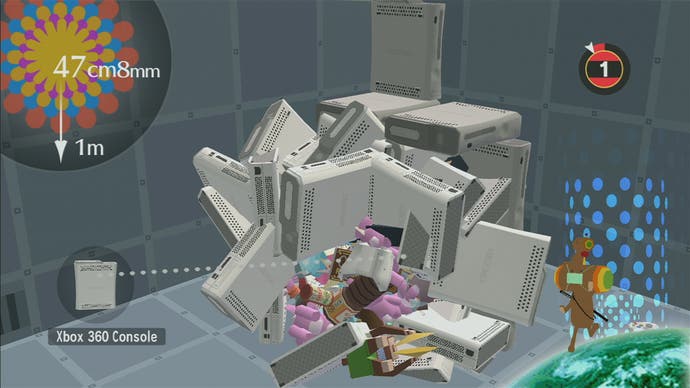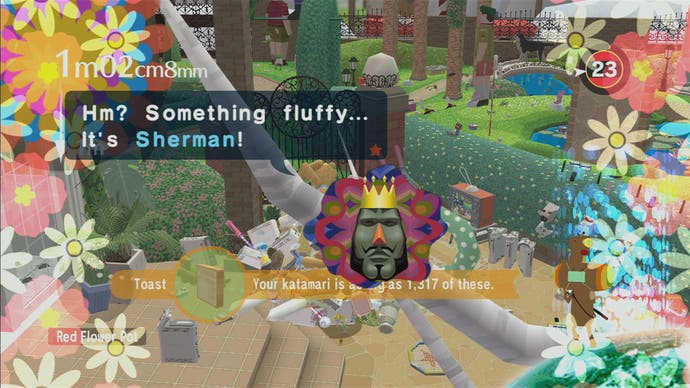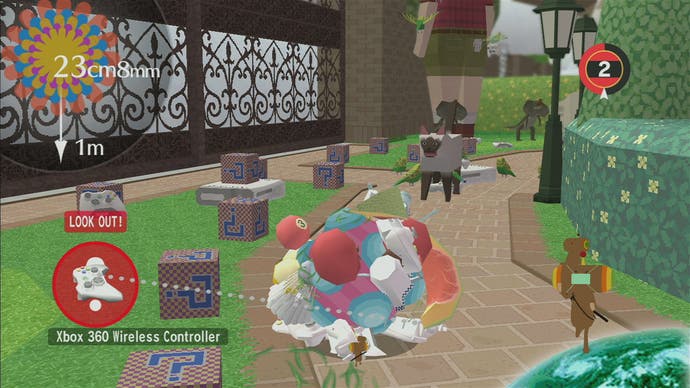TGS: Beautiful Katamari
Depends on the beholder.
There's something wrong about this. We've written about Katamari games dozens of times in the past, but we've rarely struggled to think of things to get excited about. Katamari has always been inherently delightful - a game that helps us remember exactly what got us into our hobby in the first place.
The two proper PS2 games were distinctive despite their similarities. The first game's journey from rolling up pencils and rubbers to blimps, stadiums and continents was impossible to put down. It was filled with wonderful music, hilarious jokes and countless charming little moments.
The second game was immediately at a disadvantage because the first game's best trick - starting off on the sitting room floor and then coming back later to roll up the entire house - was nothing new. Despite this, it maintained that charm with ingenious new gameplay ideas. It was as essential as the first. And the music, which we've thrown on in the background as a reminder, was arguably even better.
The third game will need a new hook. At the moment, it's hard to see what that is.
Perhaps Namco Bandai simply hasn't shown it off yet. At a pre-TGS event last week, players were introduced to the four-player competitive online game, where players can roll a football around in the lobby to kill time and then try and make the biggest katamari or collect specific objects as set out by the King of All Cosmos. Offline two-player modes, including co-op, are also in.

But it's hard to spot anything fundamentally different anywhere else. The TGS show-floor demo turns out to be a single stage set in a Japanese house where all the familiar items are strewn about - rubbers, drawing pins, playing cards and other household objects - and the idea was entirely familiar: create a ball 20cm in diameter within a two-minute time limit.
Graphically it's like pulling on a crisp new shirt that's the same as all your old ones: perfectly comfortable, but slightly dull. It's in high definition, there's what seems to be a greater density of pliable materials lying around, and there's none of the PS2 versions' slowdown to bother about.
But beyond that, the controls are the same, the setting is the same, the objective is the same, the camera is the same (and has the same problems), and even the extras look the same - at one point, one of the Prince's cousins creeps into view, suggesting that each level will have similar unlockables. Worryingly, even the things you roll up seem to be the same, even if there are more of them. When you complete the level, the King raises or lowers his big toe in approval.
One big difference this time around is the introduction of premium downloadable content. Namco Bandai last week said to expect additional levels that have a particular focus. For example, you might have to build a ball out of hot objects in order to satisfy aliens from a toasty planet, who get pissed off with too many fridges and polar bears. They also demoed a level where you had to roll around a supermarket collecting lots of inexpensive food in order to stay within your budget.

When you put that next to the things We Love Katamari came up with - like rolling up fires in pitch-black levels, or rolling a thin man into a sumo wrestler - they are certainly comparable, but seem to have less impact the second time around. We've yet to relive the joy we experienced, say, rolling around a zoo collecting giraffes and lions while a chorus of animals barked and roared their way through the original theme tune in the background.
One possible reason for this lack of excitement is perhaps a bit on the obvious side: series creator and enjoyable outspoken developer Keita Takahashi is no longer involved, just as he wasn't on the less celebrated PSP spin-off. Indeed, Takahashi was quite content that he was done with Katamari. He was widely reported to have said that he didn't even want to do the second one.
None of this is to say that new director Jun Morikawa is incapable of delivering something special. But it is hard not to make a connection between the underwhelming sensation of playing and reading about Beautiful Katamari and the Creator of all Katamaris' continued absence.
That said, it is worth remembering that Katamari Damacy itself was never released in PAL territories, and that We Love Katamari was in short supply when it eventually was. Plus, it was on PS2. Beautiful Katamari is an Xbox 360 exclusive. If Morikawa and his team are attempting to recapture and rebuild the essence of the first two games and present it to a new audience, it will be hard not to recommend to the majority of European gamers.

It's also hard not to look at what the first game attempted on limited hardware - rolling up the world - and imagine what the extra orders of magnitude the 360 can throw at the problem could deliver.
That would be an acceptable result for many. Even so, it's hard not to view what we know and have experienced of Beautiful Katamari so far through the eyes of gamers who have poured themselves into Katamari fandom since the first time we plugged the disc into a Japanese PS2 several years ago.
From that perspective, there's definitely something wrong. We only hope that the error is our pessimism, and that the best is yet to reveal itself. Look out for a full review of the game in the near future, with the Japanese and US versions due out in the week of 15th October.
Beautiful Katamari is due out on Xbox 360 in the US on 16th October and in Japan on 18th October. We expect it to arrive in Europe next year.


.png?width=291&height=164&fit=crop&quality=80&format=jpg&auto=webp)




.jpg?width=291&height=164&fit=crop&quality=80&format=jpg&auto=webp)
